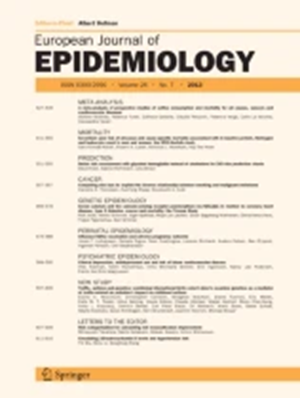Associations of coagulation parameters and thrombin generation potential with the incidence of type 2 diabetes: mediating role of glycoprotein acetylation.
IF 7.7
1区 医学
Q1 PUBLIC, ENVIRONMENTAL & OCCUPATIONAL HEALTH
引用次数: 0
Abstract
Hypercoagulability is characterized by abnormal elevations of coagulation factor levels and increased thrombin generation potential. Prior studies demonstrated links between impaired glucose metabolism, endothelial dysfunction, and hypercoagulability. However, the associations between hypercoagulability and incident type 2 diabetes as well as its underlying mechanism remain unclear. We aimed to assess the associations between coagulation parameters including coagulation factor (F) VIII, FIX, FXI, fibrinogen, thrombin generation potential (lag time, endogenous thrombin potential [ETP], peak, time-to-peak, velocity) and incident type 2 diabetes, and to study the underlying mechanism by examining the mediating role of glycoprotein acetylation (GlycA). In the Netherlands Epidemiology of Obesity study, we applied a Cox Proportional-Hazards Model in 5718 participants after adjustment for confounders. We further conducted a mediation analysis investigating the mediation effect of GlycA on the observed associations. During a median follow-up of 6.7 years, 281 incident type 2 diabetes diagnoses were reported. Compared with the lowest quartile, hazard ratio (95% confidence interval) of the highest quartile was 2.47 (1.48-4.14) for FIX, 1.37 (0.85-2.20) for FVIII, 1.11 (0.76-1.63) for FXI, 0.98 (0.65-1.48) for fibrinogen, 1.56 (1.07-2.28) for ETP, 1.84 (1.23-2.74) for peak, 1.59 (1.08-2.33) for velocity, 0.92 (0.62-1.38) for lag time, and 1.21 (0.86-1.70) for time-to-peak. GlycA mediated only a small proportion of all observed associations. In conclusion, elevated levels of coagulation factor and thrombin generation potential are associated with incident type 2 diabetes, suggesting the involvement of hypercoagulability in the pathogenesis of type 2 diabetes.凝血参数和凝血酶生成潜能与 2 型糖尿病发病率的关系:糖蛋白乙酰化的中介作用。
高凝状态的特点是凝血因子水平异常升高和凝血酶生成潜能增加。先前的研究表明,糖代谢受损、内皮功能障碍和高凝状态之间存在联系。然而,高凝状态与 2 型糖尿病发病之间的关联及其内在机制仍不清楚。我们旨在评估凝血参数(包括凝血因子 (F) VIII、FIX、FXI、纤维蛋白原、凝血酶生成潜能(滞后时间、内源性凝血酶潜能 [ETP]、峰值、峰间时间、速度))与 2 型糖尿病发病之间的关联,并通过研究糖蛋白乙酰化 (GlycA) 的中介作用来研究其潜在机制。在荷兰肥胖症流行病学研究中,我们在对混杂因素进行调整后,对 5718 名参与者采用了 Cox 比例-危害模型。我们进一步进行了中介分析,研究 GlycA 对观察到的关联的中介效应。在中位随访 6.7 年期间,共报告了 281 例 2 型糖尿病病例。与最低四分位数相比,最高四分位数的 FIX 危险比(95% 置信区间)为 2.47 (1.48-4.14),FVIII 为 1.37 (0.85-2.20),FXI 为 1.11 (0.76-1.63),0.98(0.65-1.48),ETP 为 1.56(1.07-2.28),峰值为 1.84(1.23-2.74),速度为 1.59(1.08-2.33),滞后时间为 0.92(0.62-1.38),达峰时间为 1.21(0.86-1.70)。在所有观察到的关联中,GlycA 只占很小一部分。总之,凝血因子和凝血酶生成潜能水平的升高与 2 型糖尿病的发病有关,这表明高凝状态参与了 2 型糖尿病的发病机制。
本文章由计算机程序翻译,如有差异,请以英文原文为准。
求助全文
约1分钟内获得全文
求助全文
来源期刊

European Journal of Epidemiology
医学-公共卫生、环境卫生与职业卫生
CiteScore
21.40
自引率
1.50%
发文量
109
审稿时长
6-12 weeks
期刊介绍:
The European Journal of Epidemiology, established in 1985, is a peer-reviewed publication that provides a platform for discussions on epidemiology in its broadest sense. It covers various aspects of epidemiologic research and statistical methods. The journal facilitates communication between researchers, educators, and practitioners in epidemiology, including those in clinical and community medicine. Contributions from diverse fields such as public health, preventive medicine, clinical medicine, health economics, and computational biology and data science, in relation to health and disease, are encouraged. While accepting submissions from all over the world, the journal particularly emphasizes European topics relevant to epidemiology. The published articles consist of empirical research findings, developments in methodology, and opinion pieces.
 求助内容:
求助内容: 应助结果提醒方式:
应助结果提醒方式:


